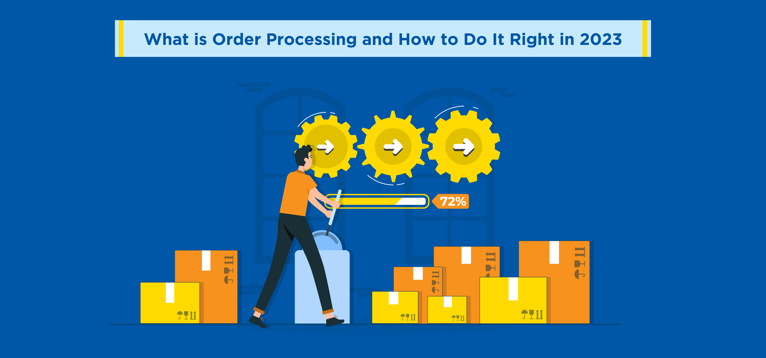In 2014, the average time to deliver packages was around 6.3 days and it came down to 2-3 days by 2019.
So what can we derive from this data?
- With the rise in online shopping volume, logistics are getting more sophisticated and accelerated.
- Customers’ hunger for faster deliveries is increasing constantly.
- Order fulfilment is becoming a decisive factor for the success of your business.
Also, note that 13% of customers that face late deliveries choose not to buy again from the same retailer. This leaves you with no room for shipping errors or delays.
And to ensure timely and accurate deliveries, you must master the order processing workflow.
In this guide, you’ll learn the ins and outs of order processing so that you can delight your customers with faster and more accurate deliveries.
What is Order Processing?
Order processing is the workflow that starts when a customer places an order and ends with product delivery. It is a crucial part of the order fulfilment process that ensures the right products are delivered to the customers.
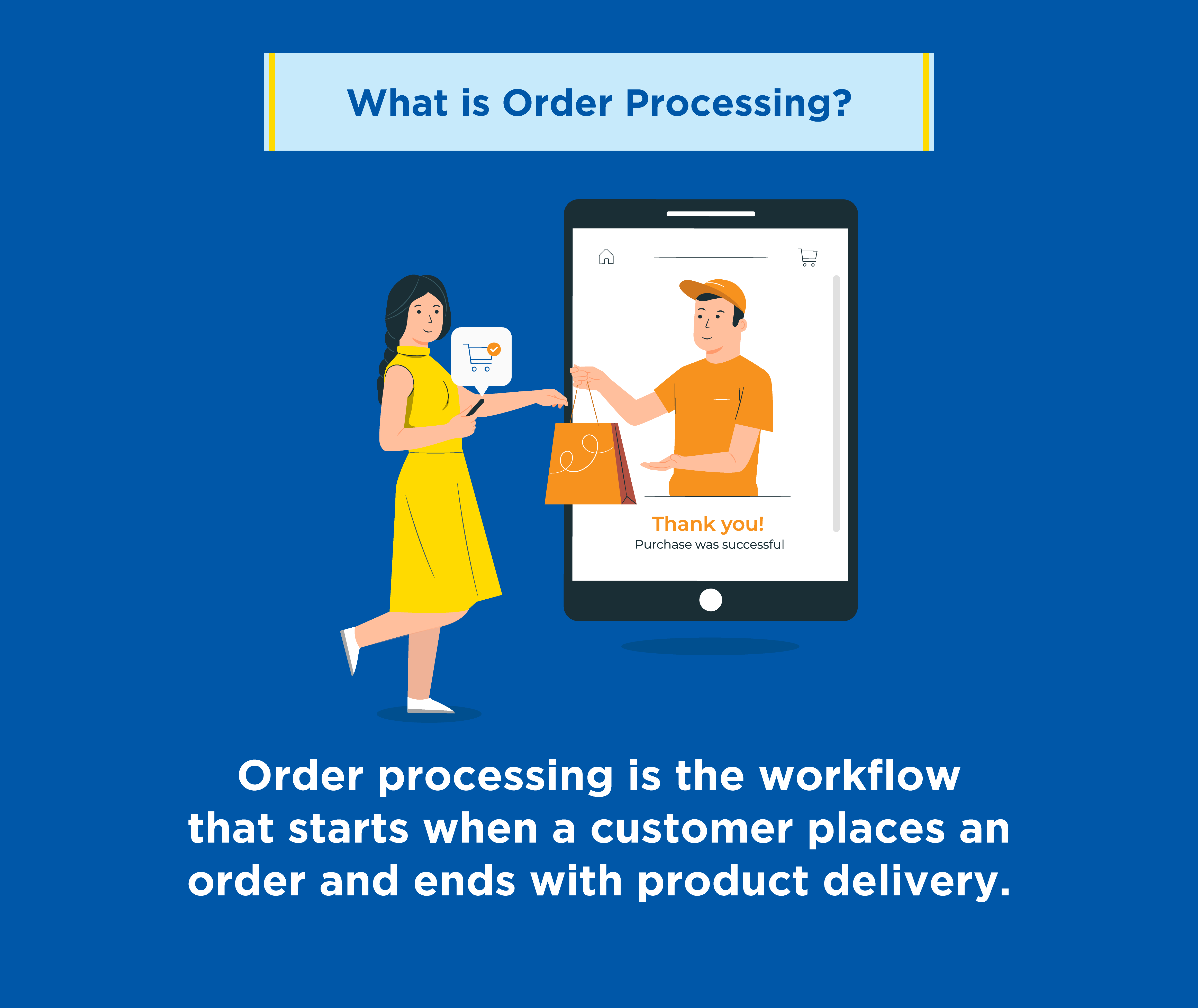
Order processing includes activities like picking, packing, and shipping. Here’s how it works for different order fulfilment models:
- In-house: If you’re handling order fulfilment in-house, your warehouse team processes the customer orders.
- 3PL: If you’ve outsourced your order fulfilment operations to a third-party logistics (3PL) provider, they process the orders for you.
- Dropshipping: In this fulfilment model, you don’t own or store the inventory. Once you get orders, you just forward them to your supplier and they directly send the products to your customers.
Order Processing Workflow
Now let’s take a closer look at the different stages of the order processing workflow.
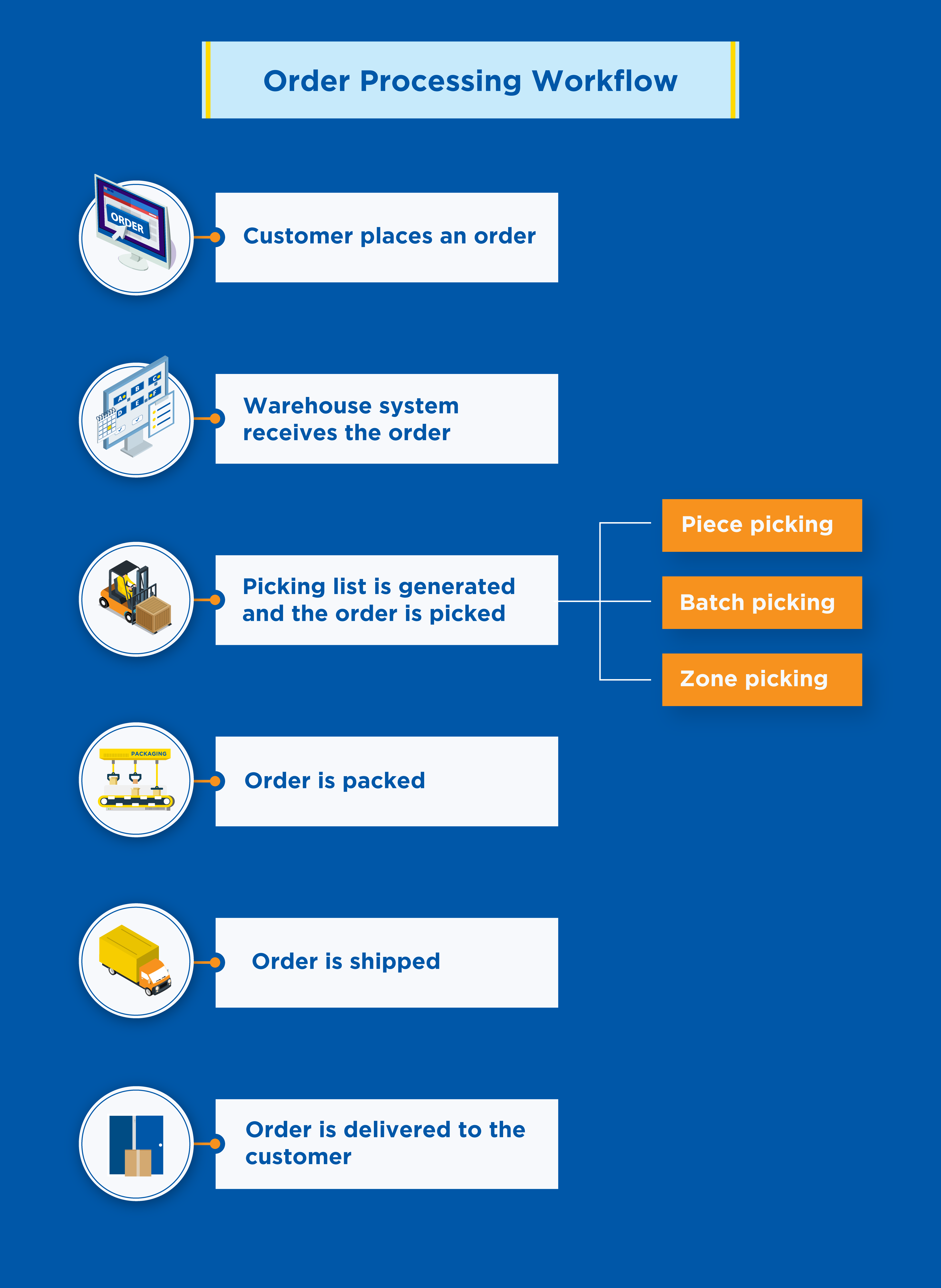
1. Customer places an order
As mentioned before, the order processing cycle begins once the customer places an order. Depending on your presence on various sales channels, your customers can place orders from channels like brick-and-mortar stores, mobile apps, websites, social media, etc.
2. Warehouse system receives the order
Once the order is placed, the sales information has to be forwarded to the warehouse or fulfilment centre.
If you have deployed an Order Management System (OMS), it streamlines order processing by collating orders from multiple sales channels and passing them to the warehouse.
Besides, an efficient OMS would also easily integrate with 3PL systems and pass the order to the fulfilment centre that is nearest to the shipping address. Thus, the orders can be delivered faster.
3. Picking list is generated and the order is picked
Next, the Warehouse Management System (WMS) generates a pick list (also known as a picking list) for the ordered items. If you haven’t invested in a WMS yet, you can also generate picking lists manually.
A pick list carries all the important order information such as product name & description, quantity, SKU number, order number, barcode, etc.
Once pickers get the pick lists, they start picking the products from the storage area. Some of the most popular picking methods are:
- Piece picking: It’s the simplest picking method that focuses on picking one order at a time. It’s suitable for small businesses with low order volume.
- Batch picking: It’s also known as multi-order picking where you can group the customer orders and pick them in batches. It saves picking time and expedites your order fulfilment process. This method is more suitable for large warehouses.
- Zone picking: Here, the warehouse is partitioned into different zones and a dedicated picker is assigned to each zone. They only pick the items stored in that specific zone so that it reduces the constant back-and-forth movement.
Besides, there are many more advanced and automated picking methods that big companies and giant fulfilment centres leverage.
4. Order is packed
Pickers pass on the picked items to the packing station. Here, the packaging team packs the products and pastes the shipping labels on them. Packers also ensure the volumetric weight of the package is optimised to reduce the shipping charges.
If you’ve outsourced your order fulfilment to a 3PL provider, they also offer you services like custom packaging, product kitting & bundling, etc. so that you can provide an enhanced customer experience.
5. Order is shipped
Once the products are packed, labelled, and ready to ship, they’re sorted and placed near the loading dock. And the partner carrier (or courier company) picks up the packages as per their daily collection schedule.
Some reputed and well-positioned 3PL providers also help you reduce shipping costs by:
- Negotiating shipping rates with carriers
- Rate shopping—requesting real-time rates from carriers
- Optimising package weight with the right packaging materials
- Getting you discounted shipping rates from partner carriers, etc.
After the order is shipped, a tracking number is generated and passed on to your customer along with the tracking link.
6. Order is delivered to the customer
Finally, the courier company delivers the orders to your customers and the order processing cycle ends unless the customer returns the product. In the case of product returns, reverse logistics also becomes a part of the order processing workflow.
Furthermore, businesses that prioritise customer satisfaction, also take feedback from customers about their buying and delivery experience. And they improvise their order processing strategies accordingly.
Order Processing Methods
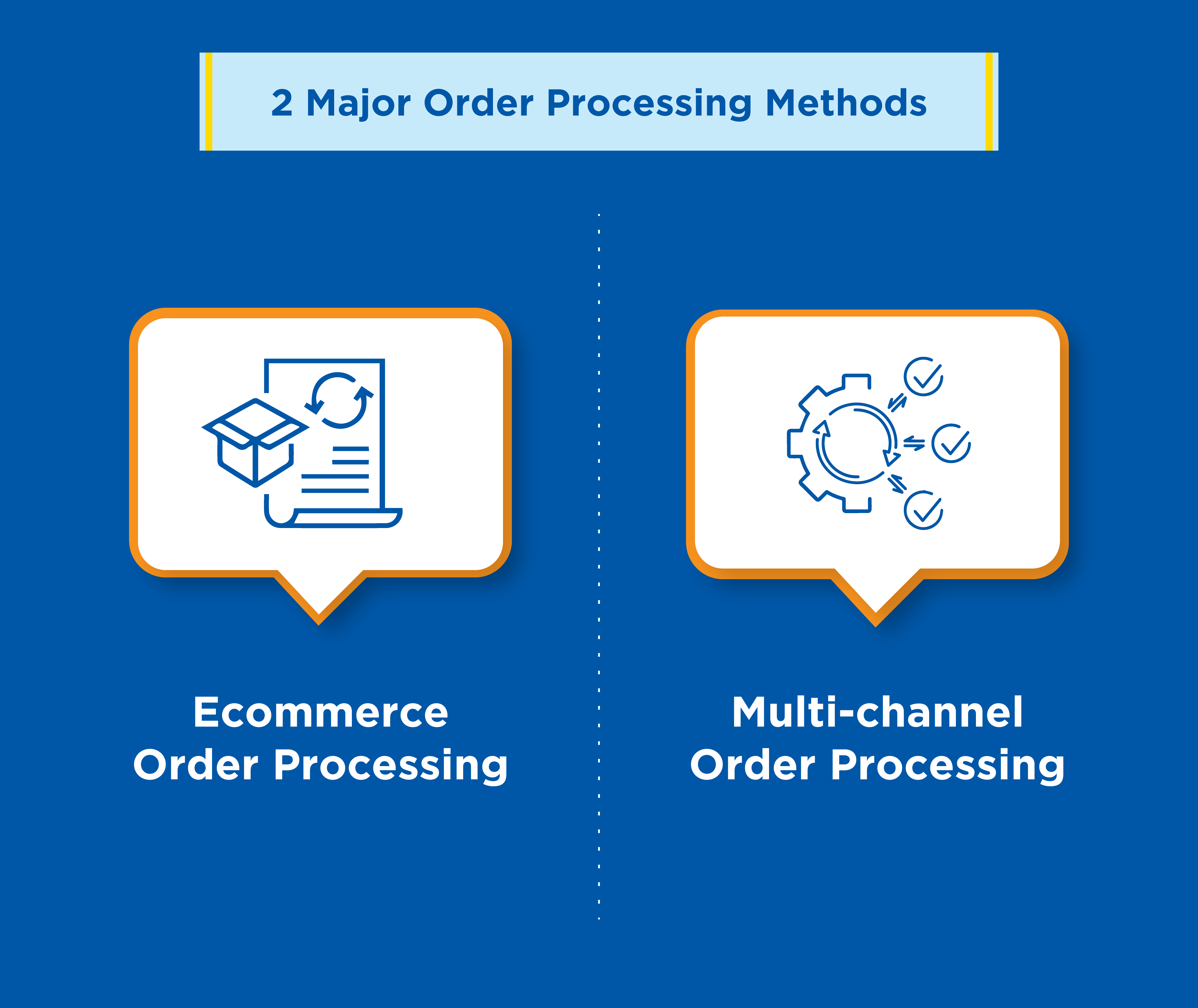
Here are some standard order processing methods that businesses use based on their business type, order volume, and sales channels.
eCommerce Order Processing
If you’re selling your products mainly through your website and mobile app, the eCommerce order processing method is ideal for your business.
This method leverages order processing automation with eCommerce software or marketplace systems. It helps you:
- Receive orders
- Send order fulfilment instructions to the warehouse or fulfilment centre
- Update stock levels
- Track customer orders, etc.
As a result, you can minimise the chances of human errors and fulfil orders faster.
Multi-channel Order Processing
Multi-channel order management helps you control the inventory and orders coming from multiple sales channels and manage them in one place.
For example, you have a retail store but you also take orders from online marketplaces like Amazon, Woolworths, etc. And, you also sell products on your website, mobile app, and social media accounts.
This is where you need to take a multi-channel order processing approach.
However, managing orders from so many sales channels while keeping your inventory updated in real-time can be a difficult task. So you’d require professional multi-channel order management software.
Factors that Impact Order Processing
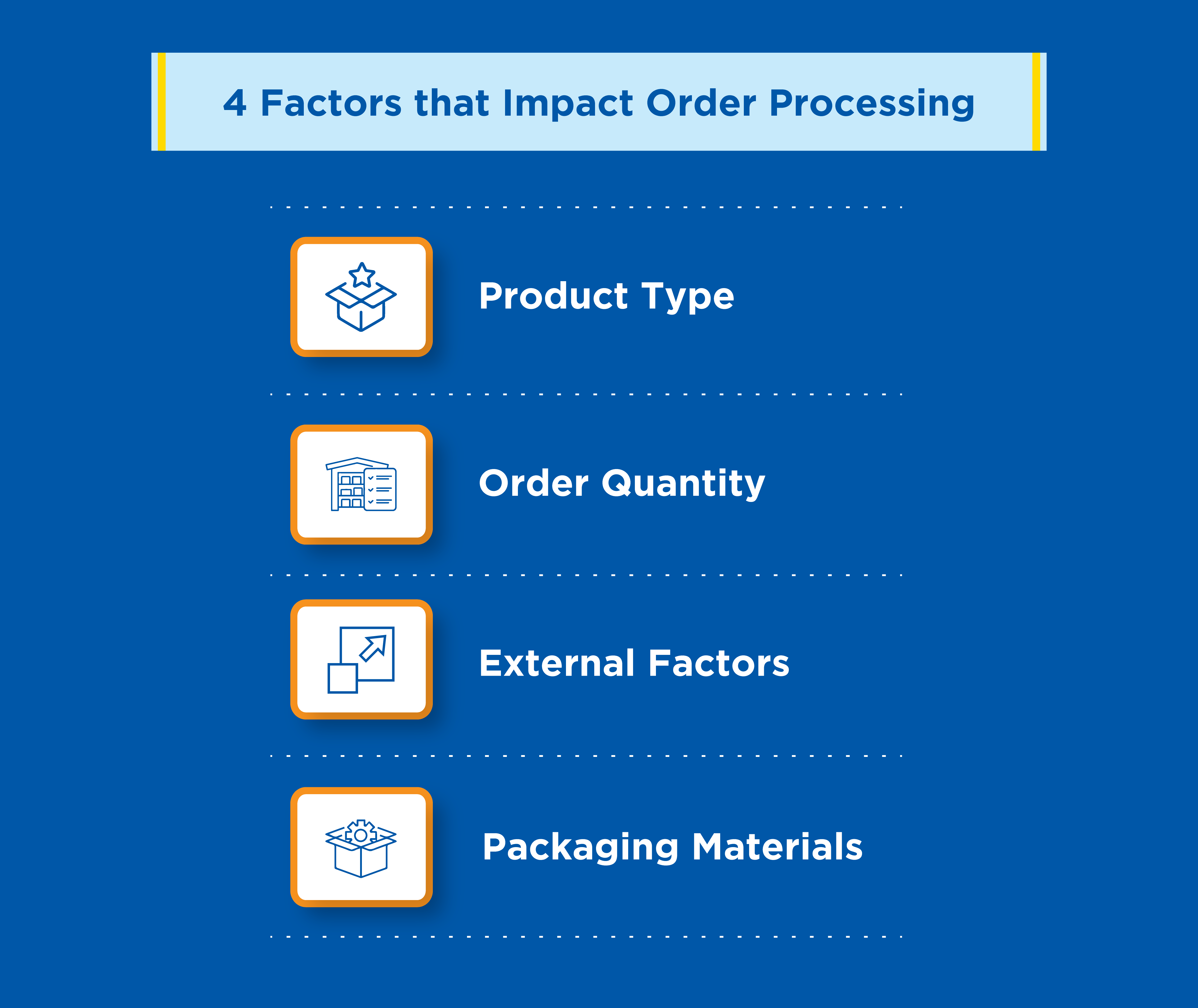
You need to consider several factors while designing your order processing workflow. We’ve outlined the most crucial factors below.
Product Type
The type of products that you’re shipping can greatly impact your order processing cycle.
For instance, if you’re shipping hazardous goods, they have to be stored, packaged, handled, and transported with extra care. In addition, you’d also need to comply with authority guidelines and approvals. These processes can take time.
On the other hand, if you’re selling generic goods like apparel, your order processing turnaround time will be much shorter.
Order Quantity
If you’re a small business with a low shipping volume, you can use a courier or postal service to send the packages directly to your customers.
But, let’s say you’re exporting in bulk quantities. In this case, you may require international freight service. Moreover, the entire order processing cycle would be much longer than low-volume shipping.
External Factors
External factors such as variations in market demand, seasonality, etc. also affect order processing.
For example, most retailers (online, offline, and multichannel) see maximum orders during the Christmas season sale—so much so that they have to hire additional staff on contract during these days.
Similarly, when there’s a sudden spike in demand for certain products, it adds pressure on the order processing operations.
As a result, the order fulfilment times are longer during such time as compared to the normal days.
Packaging Materials
How your shipments are required to be packed can also influence the order processing tasks.
For instance, how a wine retailer would pack and ship a few wine bottles to customers would be totally different from how a manufacturer or wholesaler would do it.
While the manufacturer would need to palletise the goods, retailers can simply pack them in corrugated boxes and dispatch them.
Order Processing Best Practices
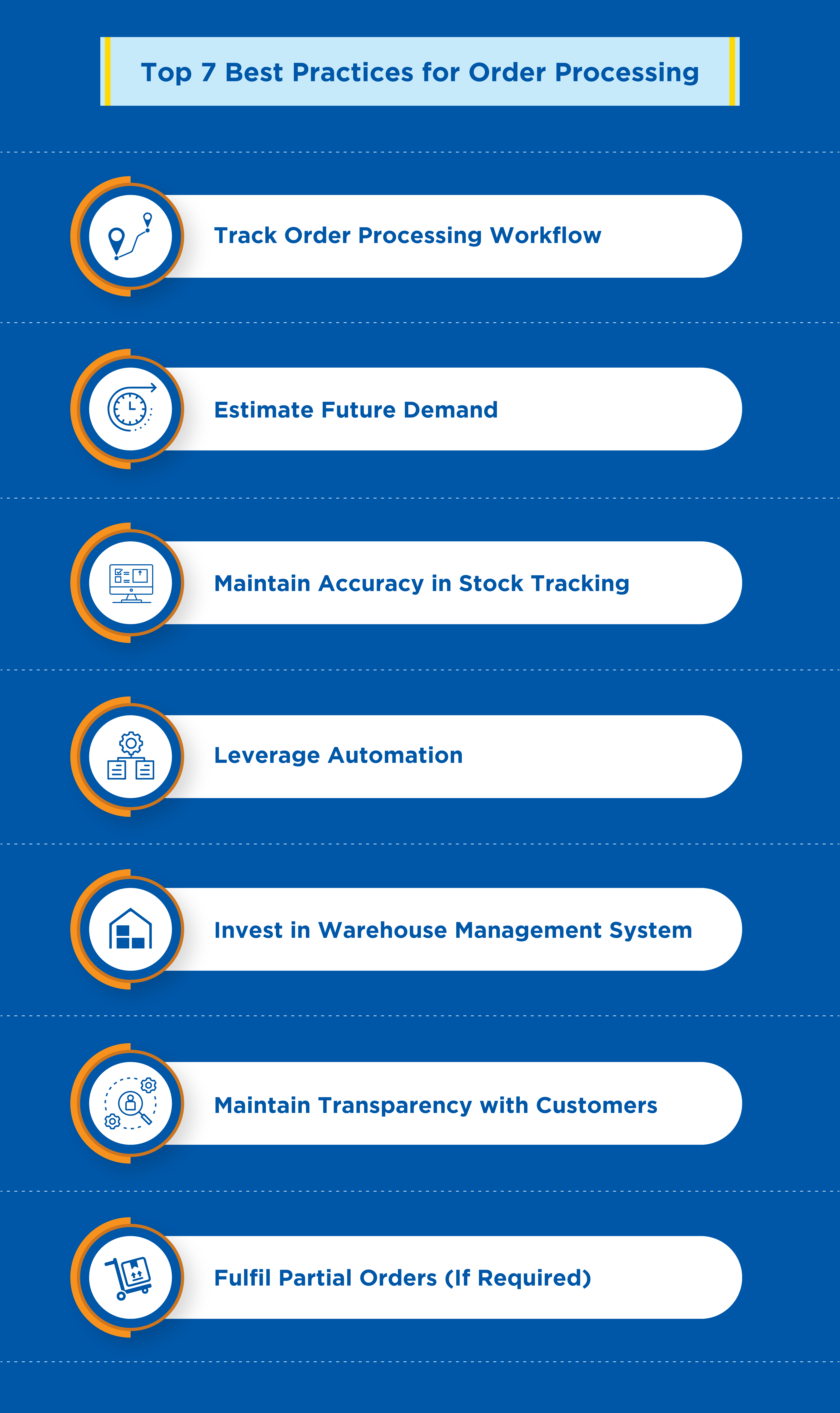
The ideal ways to process orders can vary for different businesses and industries. So you need to determine what works best for your business.
That said, here are some of the common best practices that apply to all types of businesses.
Track Order Processing Workflow
To improve the efficiency of your order processing operations, you must track each stage of the cycle closely. That’s how you’ll be able to find gaps in your processes and fill them.
This will help you improve the efficiency of your overall order-processing workflow.
At the same time, you can also keep a close tab on individual processes if it’s becoming a bottleneck. For example, if there’s a high number of complaints for “wrong product delivered”, you may want to inspect the picking operations.
Similarly, if a lot of customers complain about “receiving damaged products”, you should check your packaging process and also how the carrier handles the shipments.
Estimate Future Demand
When you have accurate demand forecasts at your disposal, you can design a detailed plan for order management well in advance. Of course, everything may not go as planned but having a plan would still help.
Let’s say, you’re running an eCommerce store and handle your order fulfilment operations in-house. And you want to determine the number of additional warehouse staff you’d need for the upcoming season sale.
Here, demand forecasting can be a great help. Also, you’d need to be hands-on with past seasons’ sales data to project near-precise sales forecasts.
Besides, demand forecasting can also help you avoid situations like overstocking or stockouts. Needless to say, both impact the business negatively.
While overstocking keeps the warehouse space occupied—adding to the storage costs, stockouts result in a loss of sales opportunities and a negative customer experience.
Maintain Accuracy in Stock Tracking
Errors in stock tracking can create chaos in your order processing activities.
For example, a product is out of stock but your inventory shows that a few units are available. So, your system accepts the customer's order. However, the picker won’t be able to find the product in the warehouse.
Now, procuring the product and getting it shipped can take a while. But your system would’ve already generated the expected delivery date and your customer is informed about the same.
You can either cancel the order and process the refund or revise the delivery date. In both cases, your customer would face inconvenience which can affect their loyalty to your brand.
Hence, you need to ensure that you have the right inventory management systems in place to help you track stock levels accurately.
Leverage Automation
Automating warehouse processes can help you optimise order processing time and costs.
Here’s how:
An OMS syncs with your sales channels and generates picking lists as soon as the orders are placed on your sales platforms. Pickers are also assigned and informed in real-time by the WMS.
Thus, the order fulfilment process begins right away without any communication delays which usually happen in manual operations. This way, the warehouse team can turn around more orders in less time and thereby improving operational efficiency and productivity.
Likewise, automated shipping systems help you get the best shipping rates by accounting the factors like destination, package weight, route optimisation, etc. And it also sends the order tracking information to your customers.
Invest in Warehouse Management System
A robust warehouse management system is key to successful and scalable order processing operations. It helps you integrate all the crucial warehousing tasks like order management, inventory management, etc. in a centralised location.
As a result, your entire order fulfilment process gets streamlined and you can deliver more orders with higher accuracy.
Maintain Transparency with Customers
Once the customer places an order, they’d like to stay on top of the delivery schedule. Hence, you must keep informing them at each stage of the shipment progress.
And most importantly, if there are any likely delays in the delivery, be proactive and communicate about the same to your customers. This shows that you care about your customers and also helps them plan accordingly.
If you’re using a decent OMS, then you don’t have to worry about sending order updates manually. This software automatically updates all the integrated systems and sends messages to customers.
Fulfil Partial Orders (If Required)
If you’re a manufacturer or wholesaler dealing in bulk orders, you might have faced this situation: You’ve received a large order but you don’t have enough stock on hand to fulfil the entire order right away.
In times like these, you can divide the order into batches (depending on the order size) and fulfil partial orders. Alternatively, you can ship the first batch of available units immediately, and the remaining ones in the next batch.
This way, your client would at least have some inventory to work with until the entire order is fulfilled.
Wrapping Up
Your order processing accuracy and efficiency directly or indirectly influence the overall customer experience.
Since customers expect faster deliveries and have multiple options (your competitors) to buy from, you don’t want to take chances with your order fulfilment.
So make sure you’re tracking your order processing operations thoroughly and keep improving them continuously. Also, follow the best practices discussed above to process your customer orders seamlessly.
At the same time, if you’d like to focus more on your core business expertise, the wisest choice is to outsource your order fulfilment operations to a competent 3PL service provider like PACK & SEND.
So that you can do more of what you’re best at—marketing and scaling your business while we take care of your logistics.
Frequently Asked Questions (FAQs)
What does order processing mean?
Order processing is a crucial part of the order fulfilment process and includes activities like picking, packing, shipping, etc. It begins once the customer places an order and ends once they receive their product.
What are the steps of order processing?
Here are the typical stages of the order processing cycle:
- Customer places an order on a sales platform such as a website or mobile application
- The Order Management System (OMS) forwards the order to the Warehouse Management System (WMS)
- WMS generates the picking list
- Warehouse staff picks, packs, and ships the items
- Carrier collects the shipment from the warehouse and delivers it to the customer
However, these steps may vary depending on the business type and requirements.
What is order processing time?
Order processing time is the calculation of the total time it takes for an order to be fulfilled. In other words, from the time a customer places an order until they receive the product, the total duration is called order processing time.
Order processing times can be influenced by factors such as product type, order quantity, market demand, seasonality, warehouse efficiency, etc.
